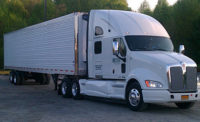Suppliers, carriers and retailers all play a role in ensuring proper temperatures are maintained when perishable products are distributed. When working in concert, they make sure the cold chain is preserved and only the freshest and safest products reach consumers. Following is a list of best practices for these stakeholders to ensure optimal cold chain management.
First, before product is transported, it should be pre-cooled by the supplier to the correct transit temperatures. It is important to get the thermal mass of the perishable product to the correct temperature before shipping, as this can have a direct impact on product quality, safety and shelf life. If product is not pre-cooled, it can continue to aspirate in the enclosed truck trailer or other container. In some cases, the product will actually generate heat, called respiration, which results in product degradation. Product should be pulped to ensure that proper temperatures have been reached before loading begins. Successful temperature control starts at the beginning with the supplier.
Pre-cooling of the transit container by the carrier should occur when the container is connected to the cold storage unit. Product temperature and container temperature need to be in equilibrium during the loading process. A container not connected to a cold storage unit should not be pre-cooled and then attached. This can create a situation that allows hotter air to enter the container causing condensation when the doors are opened and loading occurs. This can create numerous problems, including the formation of ice and structural damage to shipping containers.
Product should be loaded in a manner that promotes air flow through the transport container. Product should not be loaded above the “load” line. In addition, the product packaging itself should promote air flow.
After pre-cooling and proper loading, product is then shipped to distribution centers within acceptable temperature ranges for the particular commodity. The following are the commonly accepted transport temperature ranges for various commodities:
56°F to 62°F – bananas
42° to 54°F – tomatoes, yellow onions, potatoes
32°F to 39°F – general produce, including leafy greens, apples, broccoli, carrots, cauliflower, mushrooms, green onions, berries, corn
28°F to 39°F – meat (beef, pork, poultry, seafood) and dairy
-10°F to 15°F – General frozen foods
Suppliers, carriers and retailers concerned with food quality and safety place temperature monitoring devices on the load to maintain correct temperatures. There are several types of temperature monitoring devices in use today, including chemical indicators, paper-based strip charts, digital devices, digital temperature monitoring devices and real-time, cellular-based trackers.
During the trip—as is the case with real-time trackers or when product is received at the distribution center—the quality assurance staff checks the temperature monitoring device for any temperature breaches. It is important the temperature monitoring device be checked because it will provide historical information on what happened to product during transit. A pulp temperature upon arrival in and of itself is not sufficient, as it will only provide temperature at that particular point in time.
There have been blind tests where product arrived at a distribution center, was pulped and showed to be at the correct temperature. However, when data from the temperature monitoring device was reviewed, it showed the refrigeration unit had been turned off for a significant amount of time during transit. Though the damage might not be immediately visible, this temperature abuse would be apparent in future quality and shelf life of the product. Temperature monitoring devices provide historical data and help prevent the receipt of substandard products. They are the “eyes and ears” of quality teams when product is outside of their direct control.
Once product is consolidated at distribution centers, it is then re-grouped and sent to the individual store or restaurant location. Product is shipped either on company-owned vehicles or subcontracted out to carriers. Many times, this segment of the cold chain does not utilize independent monitoring devices to validate temperatures have been maintained. However, this is an extension of the cold chain and should not be overlooked.
Note that cold chain monitoring programs can vary from company to company ranging from none at all to very comprehensive programs. The perishable industry generally accepts that temperature monitoring programs by suppliers, carriers and retailers be adopted and include the following elements:
- Recommended safe temperature transport range guidelines for the most popular commodities.
- Requirement that perishable products be pre-cooled to acceptable transit temperatures before transport begins.
- Documented handling procedures when loading into a container
- Temperature monitoring devices and/or real-time trackers for monitoring perishable products in all segments of the cold chain, including supplier to distribution center and distribution center to retail/restaurant location. These recording devices will help suppliers, carriers and retailers pinpoint where weak points in the cold chain exist so that solutions can be implemented.
Benefits and costs
Best practices in cold chain monitoring are not cost prohibitive to implement. Costs can be very low depending on the application and if an effective program is put in place and communicated. Conversely, perishable products that are not handled properly could adversely affect thousands of people, negatively impact brand and have significant impact on revenue. A comprehensive cold chain management program mitigates risk.



